Nocturnal feeding is an animal behavior characterized by nocturnal activity, mainly by sleeping during the day as this reduces the risk of predation, or by excessive daytime temperatures and competition. of other animals. Among the hundreds of species of nocturnal animals, there are many beautiful-looking animals. Let's find out with Toplist!
1 Australian Flying Squirrel
The Australian Flying Squirrel, also known as the Sugar Glider, is a nocturnal animal native to the forests of Australia and Indonesia. These animals are named after their unique ability to move. Their food is mainly sugary fruits and vegetables. Flying squirrels have a membrane between their wrists and ankles and it allows them to fly between trees. The Australian Flying Squirrel lives in packs and is considered an exotic pet in some parts of the world.
The Australian flying squirrel is nocturnal. They sleep during the day and forage at night. The Australian flying squirrel's large eyes enhance night vision. They also have an excellent hearing that helps locate prey in the dark such as insects and rodents.
Adult flying squirrels are 18–30 cm long, including the tail, when adults can weigh up to 200g, they have an extremely soft coat with a black stripe running down their body and possess A thin membrane extending from the middle of the arm to the end of the hind leg gives them the ability to fly up to 60-100 meters in seconds. They live in the forest. Newborn cubs will automatically crawl into a small bag in front of the mother's chest and suckle until they are stronger. They are quite intelligent like dogs. They can remember their names if they play with them often. They are quite gentle, they can play with domestic pets such as dogs, cats, parrots. They love to climb, run and jump. The life expectancy of the Australian Flying Squirrel is quite high from 12-15 years.
The Australian flying squirrel is a pet that has won the hearts of young people today, with a gentle appearance, soft fur, lovely big eyes and especially the ability to fly in the air very interesting. They are easy to tame and close to humans. When caring for them, people often feed sweet-tasting species such as flowers, nectar, pollen, tree buds, sap, leaves, seeds, and insects.
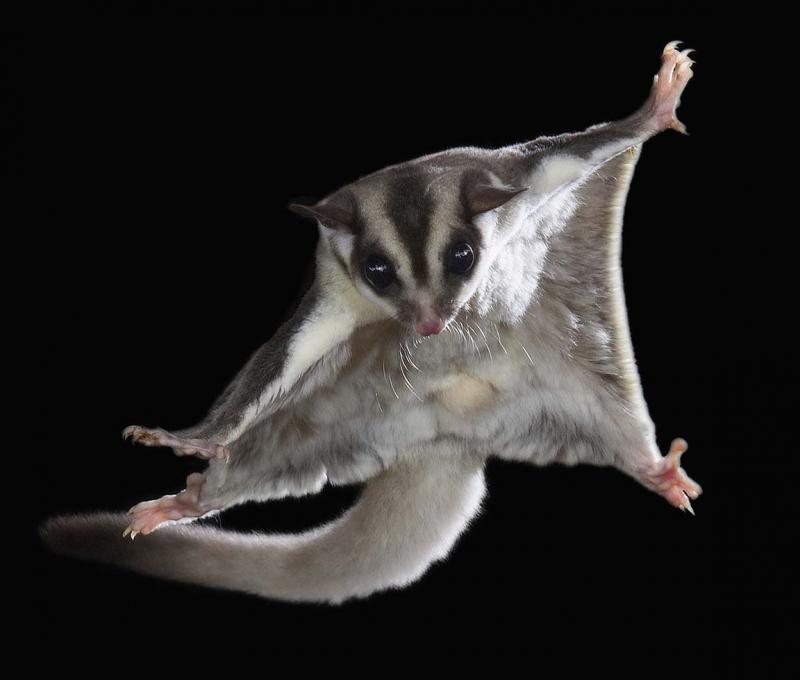
2 Luna Moth
The Luna moth is a large nocturnal butterfly, the Luna moth found in the woodlands of North America. The night Luna moth is admired for its large green wings with yellow bands. The wingspan of the Luna moth is approximately 12 cm. Luna moths feed only at night and often fly in circles around outdoor lights. The larval stage of Luna moths lasts 3-6 weeks. During this period they feed continuously on different trees such as cherries, chestnuts, walnuts and pecans. They only live for 7 days when turning into an adult Luna butterfly. Mating and feeding are the sole jobs of the Luna moth during their short lifespan.
The Luna moth is a moth with calcareous blue wings and a white body. Larvae are green. It is a New Zealand moth in the family Saturniidae, subfamily Saturniinae. This butterfly is found in North America, from east of the Great Plains in the United States – Florida to Maine, and from Saskatchewan eastward through central Quebec to Nova Scotia in Canada.
They usually have a female span of about 114 mm (4.5 in), but can exceed 178 mm (7.0 in), making them one of the larger moths of North America. Across Canada, they breed once a year, with winged adults appearing in late May or early June, while further south it will have two or even three litters per year, first appeared in early March in the southern United States.
As defense mechanisms, the larvae clack as a warning and also roll up their intestines, which has been confirmed to have a deterrent effect on a variety of predators. The long tails of the hindwing are thought to confuse echolocation detection used by predatory bats. A parasitic fly intentionally introduced into North America for biological control of the invasive species Lymantria dispar appears to have had a negative effect on this and other native moth species.
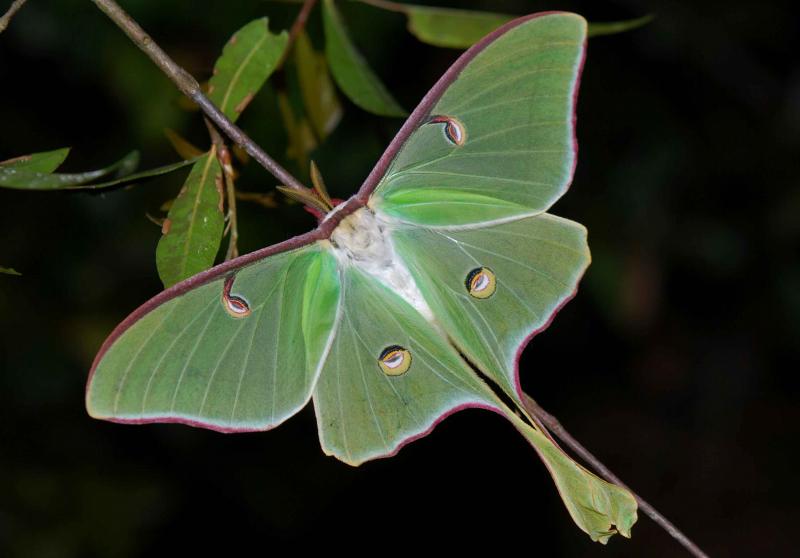
3 Slow Loris
The Slow Loris, also known as the slow loris, is a nocturnal primate found in Southeast Asia. There are 5 different species of Slow Loris in the world. They usually spend the day sleeping on tree branches and feed at night. Slow Loris possesses powerful fingers, thanks to which they can move quickly through branches. Slow Loris also have an extremely good sense of smell, thanks to which they locate their prey. Slow Loris mainly eats small birds, reptiles, eggs and even fruit.
Slow Loris live mainly in green forests of primary or secondary forests. Their food is insects, beetles, fruit, leaves, eggs and young birds in the nest... They live in all forest habitats, including bamboo forests, shrub hills and hills. … As nocturnal animals, during the day they curl up and sleep in the bushes. They are mainly active at night, in the open forest, on the stumps, bushes near the forest, on the upland fields.
The distinguishing feature of this lovely little monkey is its soft tawny fur with a few silvery white hairs. There is a white spot along the bridge of the nose. There is a crimson stain along the back. Silvery white belly. An adult Slow Loris is only 19 - 23 cm, weighing from 377 grams to 450 grams.
The reproductive organs of Slow Loris are most fully developed when the female is 16 months old and the male is 18 months old. Their gestation period usually lasts from 184 to 200 days. When young, Slow Loris will cling to the mother's belly. After six months, they will wean.
In Vietnam, the small loris is on the list of plants and animals prohibited from exploitation and use for commercial purposes.
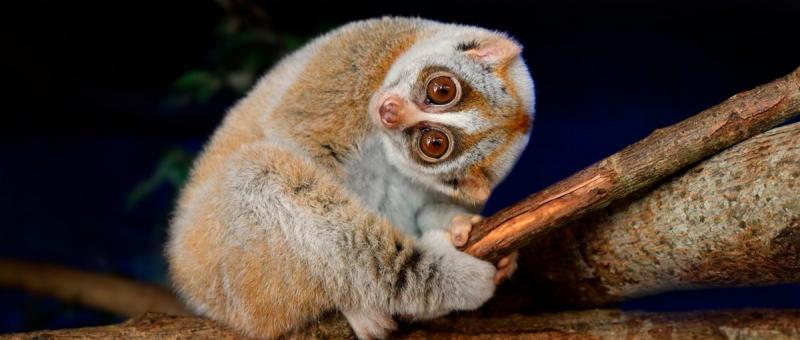
4 Red-eyed Frogs
A colorful frog, they often live in the tropical forests of Central America and southern Mexico.
Most individuals possess a blue body. They spend most of the day camouflaged under leaves and are active only at night. When feeling threatened by predators, the red-eyed frog often opens its eyes wide to surprise predators.
The red-eyed frog (scientific name: Agalychnis callidryas) is a species of sharp arboreal frog native to the neotropical rainforests of Central America. Red-eyed frogs have red eyes and orange toes. Males range in length from 5.08 cm to 6.35 cm and females from 6.35 cm to 7.62 cm. Juveniles are typically brown and turn more green as they grow, although adult frogs can change their skin color slightly depending on the environment. This species has soft skin that breaks easily on the belly and the skin on the back is thicker and rougher.
The red-eyed tree frog is one of the most colorful and well-known tree frogs in the world. This tree frog lives mainly in lowland tropical rainforests stretching from southern Mexico to northern Colombia. They have the ability to climb trees and balance on trees thanks to their small bodies with sharp claws. Unlike many amphibians living in the same territory, the Red-eyed Frog appears to be less affected by the chytrid fungus (Batrachochytrium dendrobatidis), which has caused the extinction of many of its relatives. Until now, scientists are not sure why they can be immune, but perhaps it is more or less due to the arboreal lifestyle of the Red-Eye Frog.
During the breeding season, the red-eyed tree frog lays its eggs on a leaf protruding from the surface of the water. After a while, the eggs will hatch into tadpoles and then dive into the water. Currently, this species of frog is being bred quite widely and quickly becoming a popular species on the "pet" market.

5 Red Pandas
A famous nocturnal creature, the red panda is commonly found in the high mountains of the Eastern Himalayas. They spend most of their time sleeping in trees, and only come down to the ground at night to forage. Thanks to their activity at night, they avoid the threat of attack from predators.
The red panda (Ailurus fulgens) is a mammal native to the eastern Himalayas and southwestern China. It is listed as an endangered species on the IUCN Red List as the wild population is estimated at less than 10,000 adults and continues to decline due to habitat loss and fragmentation, poaching and deforestation. reduced inbreeding. Despite its name, the species is not closely related to the giant panda.
The red panda has reddish-brown fur, a long, shaggy tail and a waddling gait due to its shorter front legs; It is roughly the size of a domestic cat, although it has a longer body and is somewhat heavier. It is herbivorous and mainly eats bamboo, but also eats eggs, birds and insects. It is a solitary animal, mainly active from dusk to dawn, and largely sedentary during the day. It is also known as the little panda and the red raccoon.
The red panda is the only living member of the family Ailurus and the family Ailuridae. It was previously placed in the pandas and bears, but phylogenetic analysis strongly supports its species classification in its own family, Ailuridae, which is part of the superfamily Musteloidea, along with with the mink, raccoon, and skunk families. Traditionally, it was thought to include two subspecies. However, the results of genetic analysis indicate that there may be two distinct species of red pandas, the Chinese red panda and the Himalayan red panda, which were genetically different 0.22 million years ago.

6 Gray Wolf
The first image that comes to mind when you think of a wolf, is it a creepy animal howling in the moonlight? But actually, wolves and moonlight are completely unrelated. Because they often howl when active at night, standing howling under the moonlight is an image of human imagination. But it's also undeniable that the howl of wolves scares us. Their howls can be heard very far, to mark their territory or to call out the opposite sex.
The gray wolf is the largest of the wolf species found in the world. They are 1m to 1.2m long and weigh up to 65kg. Gray wolves are usually active at night thanks to their very good tracking ability. The cool night temperature also partly makes them save body energy.
As superior predators, gray wolves are an integral part of the ecosystem in which they live. Gray wolves live in areas: forests, deserts, mountains, tundra, taiga, and savannahs and even cold snowy regions. Habitat use by gray wolves is strongly correlated with prey abundance, snow conditions, the absence or low density of livestock, road density, human presence and terrain. image.
In cold climates, gray wolves may reduce blood flow near the skin to conserve body heat. The warmth of the feet is regulated independently of the rest of the body, and is maintained just above the freezing point of the tissue, where the pads come into contact with ice and snow. Gray wolves use different places to rest during the day: covered areas are preferred during cold, wet, and windy weather, while dry-weather wolves often choose open spaces. to rest. During the fall-spring period, when wolves are more active, they are willing to lie outdoors, regardless of their habitat.
The actual caves are usually built for the cubs during the summer time. When building burrows, the maggots use natural shelters such as cracks in the rock, cliffs overhanging riverbanks, and holes covered with vegetation. Sometimes this is a suitable cave for smaller animals such as foxes, badgers or marmota. A proper cave is usually expanded and partially reworked. On rare occasions, female wolves burrow themselves, usually small and short with 1-3 holes. Caves are usually built no more than 500 m (550 yd) above the water source, and often face south, thus ensuring adequate sunlight, keeping the negation area relatively snow-free.

7 Raccoon Weasel
The raccoon, also known as the gray-haired carnivore, is a nocturnal mammal found mainly in wooded areas throughout North America. Regarded as having excellent hearing and sight, they are also known for their thick, beautiful coat and gray-black coloration. In addition to having good vision, Raccoons also have excellent mobility, they can travel about 30km a night in search of food. Raccoon's favorite foods are: Insects, eggs, fish and sometimes they also eat seeds and fruits.
As with most exotic pets, owning a Raccoon usually takes a considerable amount of time and patience. Raccoons can act erratically and aggressively and it can be quite difficult to teach them to obey and understand commands. Places where raccoons are kept as pets are not prohibited, such as in Wisconsin and other US states, requiring an exotic pet permit.
Sexually mature raccoon ferrets often engage in natural aggressive behavior such as biting during the breeding season. Castrating them at around five or six months of age reduces the chances of developing aggressive behavior. Raccoons can become obese and have other disorders due to poor diet and lack of exercise. When fed with cat food for a long time, Raccoons can develop gout. As for the results of research on their social behavior, it is required by law in Austria and Germany to keep at least two individuals to avoid making them lonely. Raccoons are usually kept in a plantation (indoor or outdoor), which is also a legal requirement in Austria and Germany, rather than in apartments where their natural curiosity can lead to property damage produce.
The Raccoon's original habitats were deciduous and mixed forests of North America, but through adaptability it has extended its range to mountainous areas, coastal marshes, and areas. urban areas, where they are considered pests by many homeowners. As a result of intentional evictions and introductions in the mid-20th century, the raccoon is also distributed throughout mainland Europe, the Caucasus, and Japan.

8 Owls
The owl is one of the most popular nocturnal birds. They are found on almost every continent except Antarctica. Possessing a beautiful coat, round head, big eyes. They often find quiet places to hide during the day and hunt at night. Considered to have excellent hearing and vision, it is also a powerful weapon that helps the owl become a killer at night.
The fact that the barn owl is completely nocturnal – combined with the eerie sound of its call – has caused it to be seen as a bad omen or a demonic creature in many cultures. But it turns out that barn owls' senses are well suited to hunting at night. But while they can see in the dark up to 100 times more clearly than humans, barn owls can often stalk their prey by sound alone. The fact that one ear is positioned higher than the other allows for a sophisticated mapping system that takes into account vertical as well as horizontal space.
Owls are usually brown, gray, and have lighter feathers on the belly and face. They are usually active at night, feeding on insects and other invertebrates. They have rather mischievous eyes, powerful flight with thick, narrow wings. They often migrate seasonally in search of food sources. Owls often nest on tall tree branches, on rooftops, their food is mainly mice, insects and other small birds. The crested owl nesting on the roof makes many people worried and scared. Especially the call of the owl.
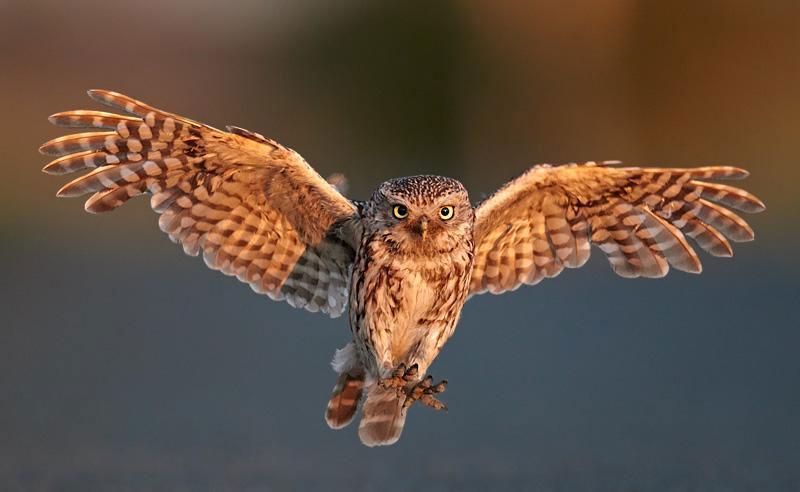
9 Eyelash Viper
The Eyelash viper is one of the nocturnal animals found in the tropical forests of Central and South America. They come in different colors such as: Blue, red, green and brown. This is a snake that usually lives on small tree branches and feeds at night. The eyelash snake's venom is strong enough to kill an adult human.
The Eyelash Viper is a relatively small venomous snake. Adults are usually only 55 to 82cm long. They have a characteristic look with different color variations and a few curved scales on the eyes like eyelashes as their name suggests. The Eyelash Viper has a broad, triangular head, round eyes with vertical pupils. The Eyelash Viper has large, needle-like fangs in the front of the upper jaw that can be folded back when not in use. The most striking feature of this species is the scales above the eyes that look like eyelashes. Eyelash Viper snakes are red, yellow, brown, green, .. even pink and have some black or brown spots along the body.
Eyelash Viper snakes are mainly nocturnal. They are not overly aggressive unless threatened. Besides, their bites are almost not dangerous to humans. This is a typical ambush predator Viper. They hunt by patiently waiting for their prey to pass by before attacking them directly. Eyelash Viper snakes are sexually mature at about two years of age. They can breed throughout the year in warm environments.
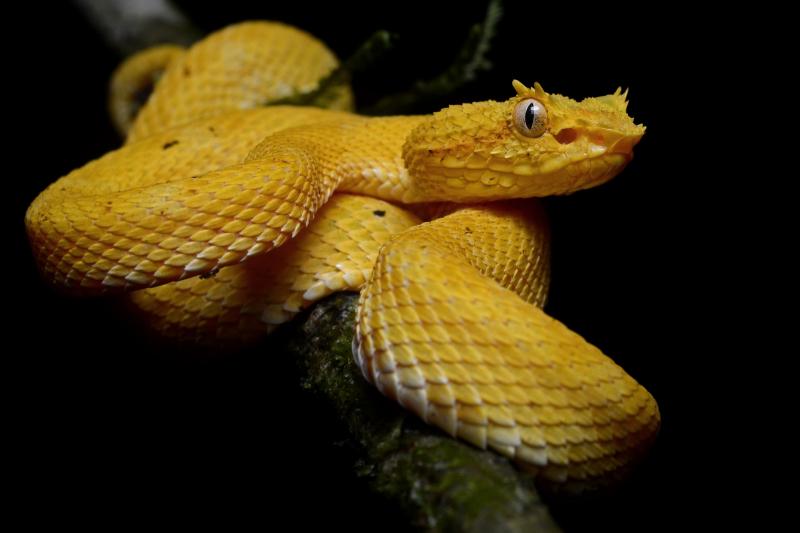
10 Indian Bats
There are about 1,000 different species of bats in the world. Almost all bats are nocturnal creatures.
Among them, the Indian bat is a special and quite fascinating species, they are found in the forests of India, China, Nepal and Banglasesh.
The Indian bat is a large bat, with a long snout, large eyes with very good night vision that makes it easier to work, long toes with sharp claws and a wingspan of up to 1.5 meters. But you don't need to worry about their damage, because this is a fruit-eating animal. They travel quite far at night in search of food. The cool nighttime temperatures also help them cool off their body heat.
Species in this order have much in common with herbivores and can be considered a clade of insectivores adapted for flight. The forelimbs transform into leathery wings. Fingers, except for the first finger, are very long and stretchy with thin, hairless skin. The membrane connects not only the forelimbs to the hind limbs, but also the hind limbs to the tail. Large pectoral muscles. The Indian bat is also featured with a unique hanging posture (hanging upside down).
Indian bats emit ultrasound with a frequency of 50,000 - 70,000 Hz. By receiving ultrasound into the ear, the bat can estimate the distance of an obstacle. However, any bat does not only use pure positioning ability, but also combines observation from the eyes while flying. With bats that often eat fruit, their visual system is very developed, with a position right on the head. Particularly for insectivores, they have smaller eyes, often used to determine altitude above the ground, perceive light levels, distinguish day and night to choose the appropriate hunting time, assess size. prey or obstacles, as well as navigation in flight for prey.
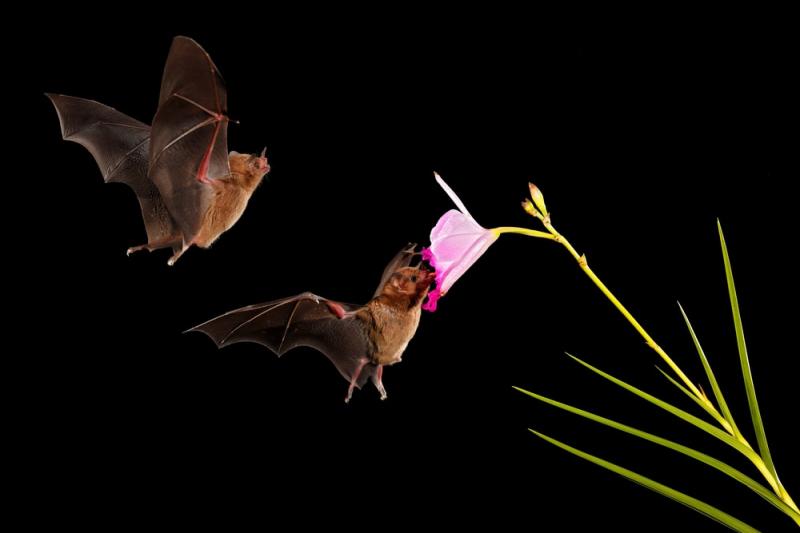
11 Spiny Cairo Mouse
While the Cairo spiny rat is only active at night, its close counterpart - the yellow spiny rat - is only active during the day. What makes this so unusual is that these two mice are physiologically similar, and the fact that they often occupy the same ecosystem and hunt for the same prey – albeit at different times of the day. These mice rely on their strong sense of smell and hearing to navigate in the dark, but they are also aided by hairs near their nose and mouth that can be used to detect objects in the dark. Whether out at night or during the day, their spiky coat makes them an unpalatable meal for many predators.
The Cairo Spiny Rat is native to northern Africa with their range extending from Mauritania, Morocco, and Algeria in the west to Sudan, Ethiopia, Eritrea, and Egypt in the east at elevations up to about 1,500 m (4,900 ft). ft). It lives in dry rock habitats with sparse vegetation and is often found near human habitation. It is common around cliffs and canyons and in gravel plains with shrub vegetation. It is not commonly found in sandy habitats, but can occur among date palms.
Cairo Spiny Rats are social animals and live in groups with a dominant male. Spawning occurs mainly in the rainy season, between September and April, when food is more readily available. The gestation period is 5 to 6 weeks, long for mice, and the pups develop well when they are born. By this time, they are already covered with short fur and their eyes are open, and they will soon begin to explore their surroundings. The adults in the group co-operated with the young, with the lactating females feeding the females in the group. Females can become pregnant again shortly after birth and give birth to three or four litters of up to five pups in a year. Juveniles mature between two and three months of age.
Spiny Cairo rats live in burrows or rock crevices and are mainly terrestrial, but they can also burrow in low bushes. They are nocturnal and omnivorous, eating anything that can be eaten. Their diet consists of seeds, nuts, fruits, green leaves, insects, spiders, mollusks and carcasses. When living near humans, they consume crops, grains and food reserves. They sometimes invade homes, especially in winter, and don't like cold weather.
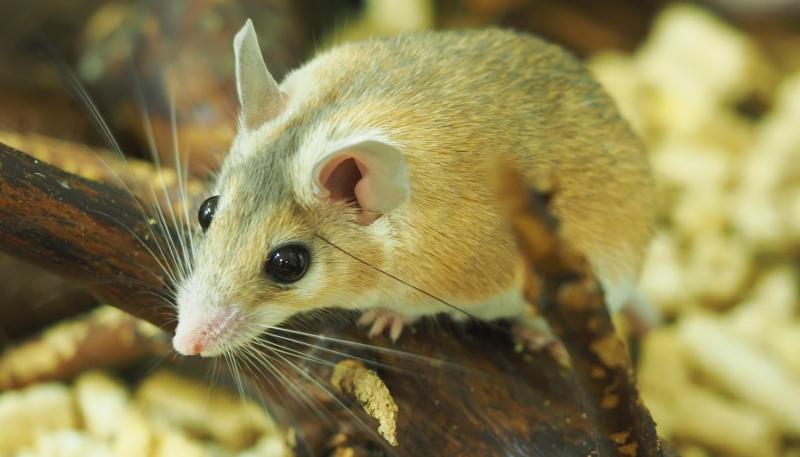
12 Black-footed weasel
The black-footed ferret is roughly the size of a weasel and differs from the European Polecat by the greater contrast between its dark limbs and pale body and shorter black tip-tail length. In contrast, the difference between the black-footed ferret and the Asian polecat is so slight that the two species were once thought to be specific. The only notable differences between the black-footed ferret and the prairie polecat are the much shorter and coarser coat, larger ears, and a longer extended posterior palate.
It is mainly nocturnal and solitary, except when breeding or brooding. Up to 91% of its diet is prairie dogs.
The black-footed ferret was on the verge of extinction in 1980, and its current populations exist because of re-establishment in their native habitat. Thanks to successful captivity, several hundred individuals were born in captivity and 500 individuals (206 adults) were released into the wild. The re-release of a small group in 1991 into Wyoming's Shirley Basin.
In the spring of 2008, there were about 500 adults spawning in the wild, fewer than 250 of which were born in the wild. The estimated number of breeding adults increased to 448 in 2009, but fell to 274 in 2012 and similarly in 2015, at 295. The estimated overall population decline from 2008 to 2015 is about 40%. Of these, 206 adults occurred in free-living and self-sustaining populations. These minimum population estimates occur in the spring.
The black-legged ferret has an elongated body with black outlines such as the paws, ears, parts of the face and tail. The forehead is curved and wide, the muzzle is short. It has few whiskers, and its ears are triangular, short, erect, and wide at the base. The neck is long, the legs are short and stout. The toes are equipped with sharp, slightly curved claws. The paws on both surfaces are covered with hair, even up to the soles of the feet, thus hiding the claws.

13 Fennec Fox
The fennec fox's small size and endearing features make it one of the desert's loveliest animals, but you'll only find it if you venture out at night. The biggest threat to fennec foxes are daytime predators such as hawks and hyenas, and so these adorable animals congregate in burrows under the sand at night. These underground dwellings also keep them safe from the harsh desert heat, and they only venture out to hunt on the ground when the night - and the temperature - drops. As omnivores, their evening hunts can lead them to insects or rodents as easily as fruits, plants, and roots.
Fennec foxes are very loyal, they live in a monogamous regime, each year giving birth to about 2 to 5 cubs. The cubs can stay with their parents even after the babies are born. When the Fennec fox is pregnant and nursing, its mate will feed, pamper and protect it.
Fennec foxes are highly social, living in groups of about 10 members. Groups of more or less members are determined by the amount of food resources available in the territory they inhabit. When in danger, this animal makes various sounds such as barking, hissing (like a cat) and growling. They have no need to drink water. Fennec foxes can live without drinking water, instead, they get water from leaves, tubers, fruits and even their prey.
Fennec foxes love the nightlife. Like so many other desert animals, the Fennec fox prefers nocturnal activity, avoiding the excruciating heat of the desert during the day. During the day, the Fennec fox spends a lot of time sleeping, storing maximum energy for the night hunting and playing. The harsh habitat causes the Fennec Fox to dig burrows in the sand in areas with stable trees and dunes. The area of these caves can be up to 120m2 and up to 15 different entrances. In some cases, they live near members of the same bloodline, Foxes will dig burrows with each other.
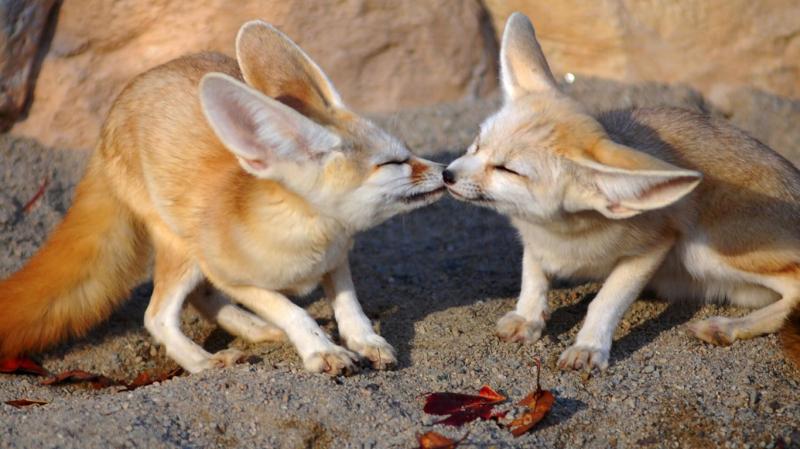
14 pygmy monkeys Tarsiidae
Many nocturnal creatures include tarsiers, some owls with large eyes relative to their body size to compensate for lower light levels during the night.
The Tarsiidae are a suborder or suborder of Primates that includes a group of primates whose ranges once varied across Europe, North Africa, Asia, and North America, with most of them today. extinct, only living species are found in the islands of Southeast Asia. Tropics or Tarsier Monkeys (Family Tarsiidae) are the only living members of this suborder.
Other fossil primates, which include Microchoeridae, Carpolestidae, and Simuliidae, have been included in this classification, although the fossil evidence is controversial. Simuliidae is also classified under the Simiiformes infraorder (with monkeys and apes). Likewise, Carpolestidae are often classified in the order plesiadapiformes, the very close, relatively extinct species of primates. This contradictory classification lies at the heart of the primate evolution debate.
Even the placement of Tarsiiformes in the suborder Haplorhini (with apes and apes") is disputed.In general, accepted members of this infraorder include the living tarsier, omomyids extinct, two extinct fossil genera, and two extinct fossil species in the genus tarsius.Like haplorhines, they are more closely related to monkeys and lemurs than strepsirrhine primates, which include lemurs, galagos, and lorises.
Tarsier monkeys have some unusual morphological features. Their ancestors lost the tapetum lucidum layer, which reflects and amplifies light. So, to make up for this shortcoming, Tarsier had to develop bigger eyes, almost as big as their brains, allowing them to see well at night, because the eyes were so big they couldn't see through. , but you have to turn your head if you want to see something on either side. They rotate their heads similar to owls and can rotate their heads 360 degrees.

15 Pangolins
The life of a pangolin is a solitary life – as they spend most of their lives in underground burrows. They spend the night expanding their impromptu burrow network and hunting for insects with their long tongues and keen sense of smell. Although there are eight different species of pangolin around the world, they are all united by the unique armored scales that cover their bodies. Unfortunately, this animal is considered a delicacy in many places and has been pushed to the brink of extinction by poachers.
The whole body of the pangolin is covered with hard scales, overlapping like scales, leaving only the abdomen. At birth, pangolin scales are soft but gradually harden as they mature. They are made of keratin, the same material as human fingernails and long, hard claws, and have a different structure and composition from reptile scales. The body surface is scaly equivalent to a pine cone. The edge of the scale is sharp and pointed to aid in defense. It can curl up into a ball when threatened, with overlapping scales acting as armor, while it protects its face by tucking it under its tail. The scales are sharp, providing extra defense from predators. They also defend themselves by spraying a solution of foul acid from glands near the anus, similar to the spray of skunks.
Pangolins have long and hard nails; The forelimbs are used to destroy nests of foraging insects, burrow into ant and termite mounds, and to climb. Because of their long claws, they do not walk by stepping on the ground, but on the contrary, pangolins move by bending their front legs and stepping on the instep. Their mouths have no teeth; The main food is ants and termites. They use their long tongues (up to 40 cm, only 0.5 cm in diameter) with very sticky drool to capture prey. The tongue is located in the ribcage, between the sternum and the trachea.
The pangolin tail has the ability to hold, to help hold onto branches when climbing. The pangolin species measure from 30 to 100 cm. Females are usually smaller than males. They nest in hollow trees or burrow deep in the ground.
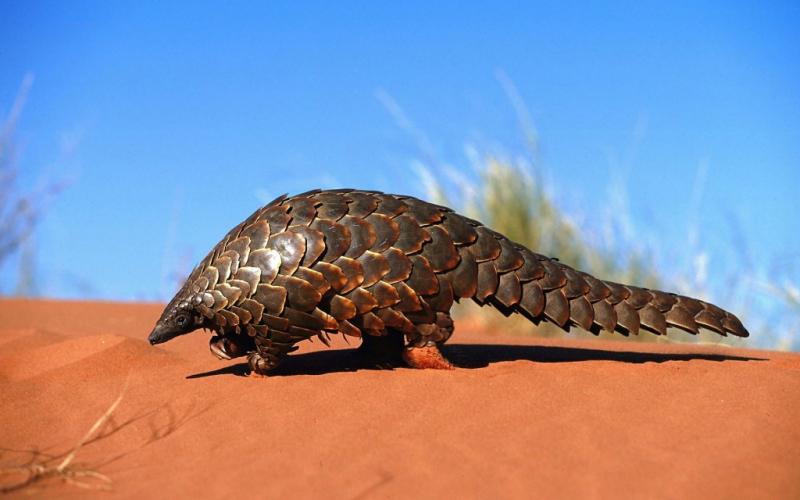
Above are the top of the most beautiful nocturnal animals in nature today that Toplist learns and provides to readers. Follow along to know more interesting things about the animal world in the following articles.










